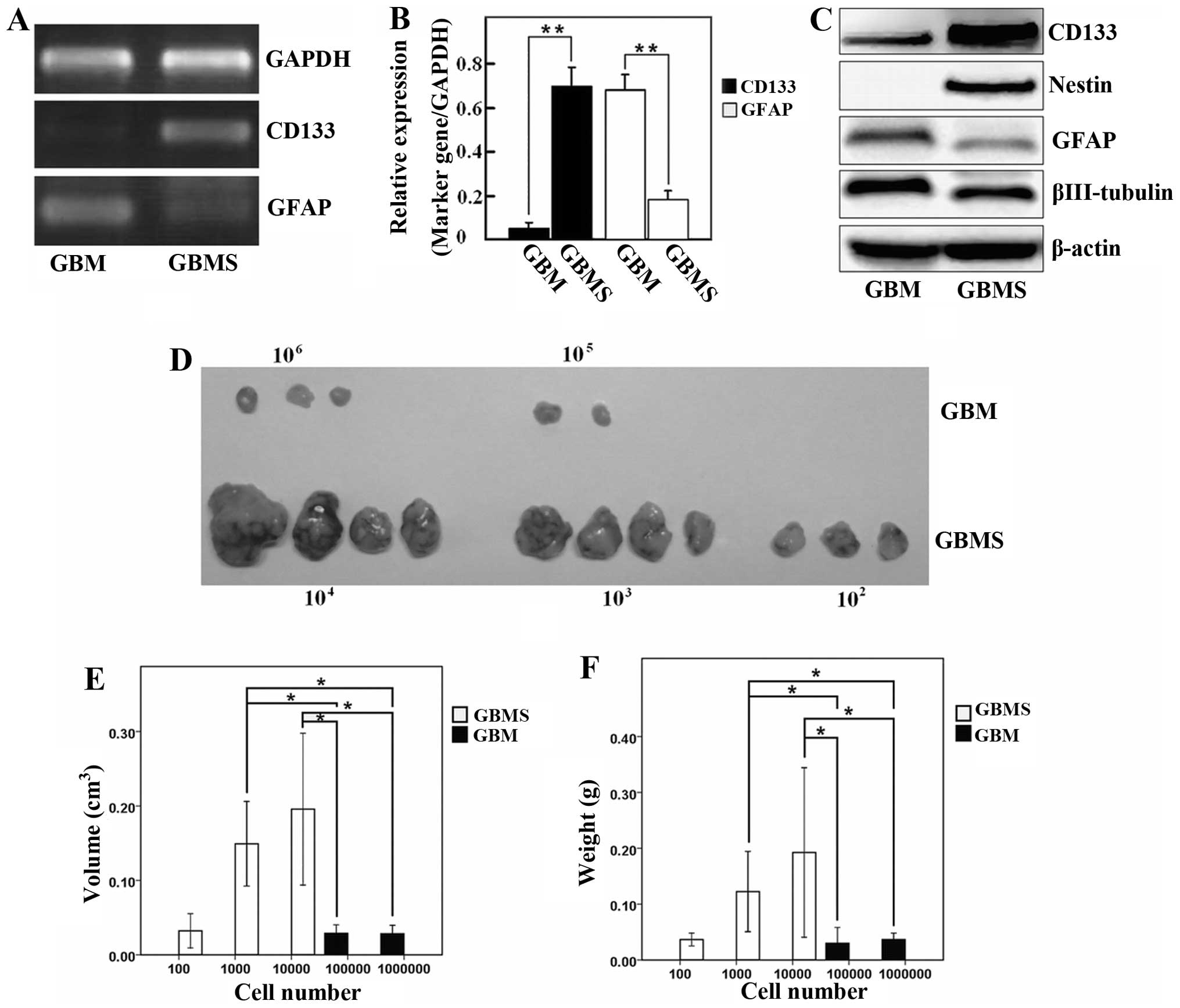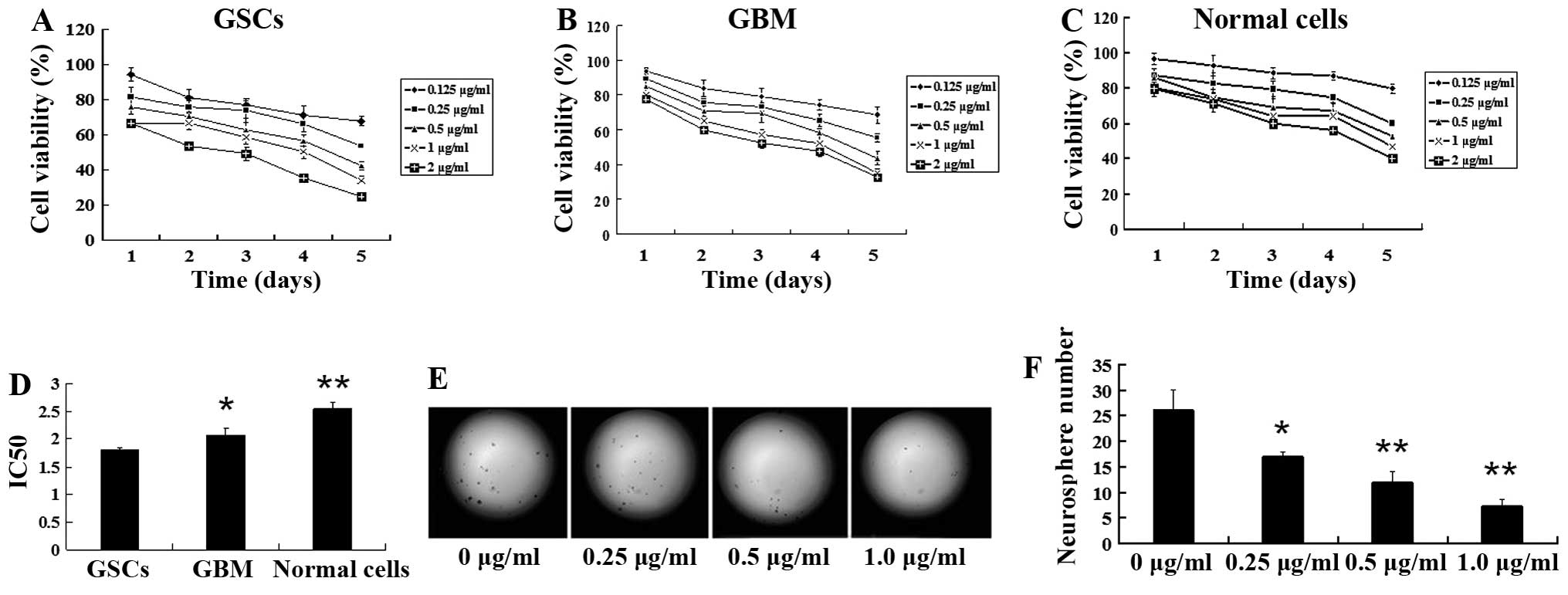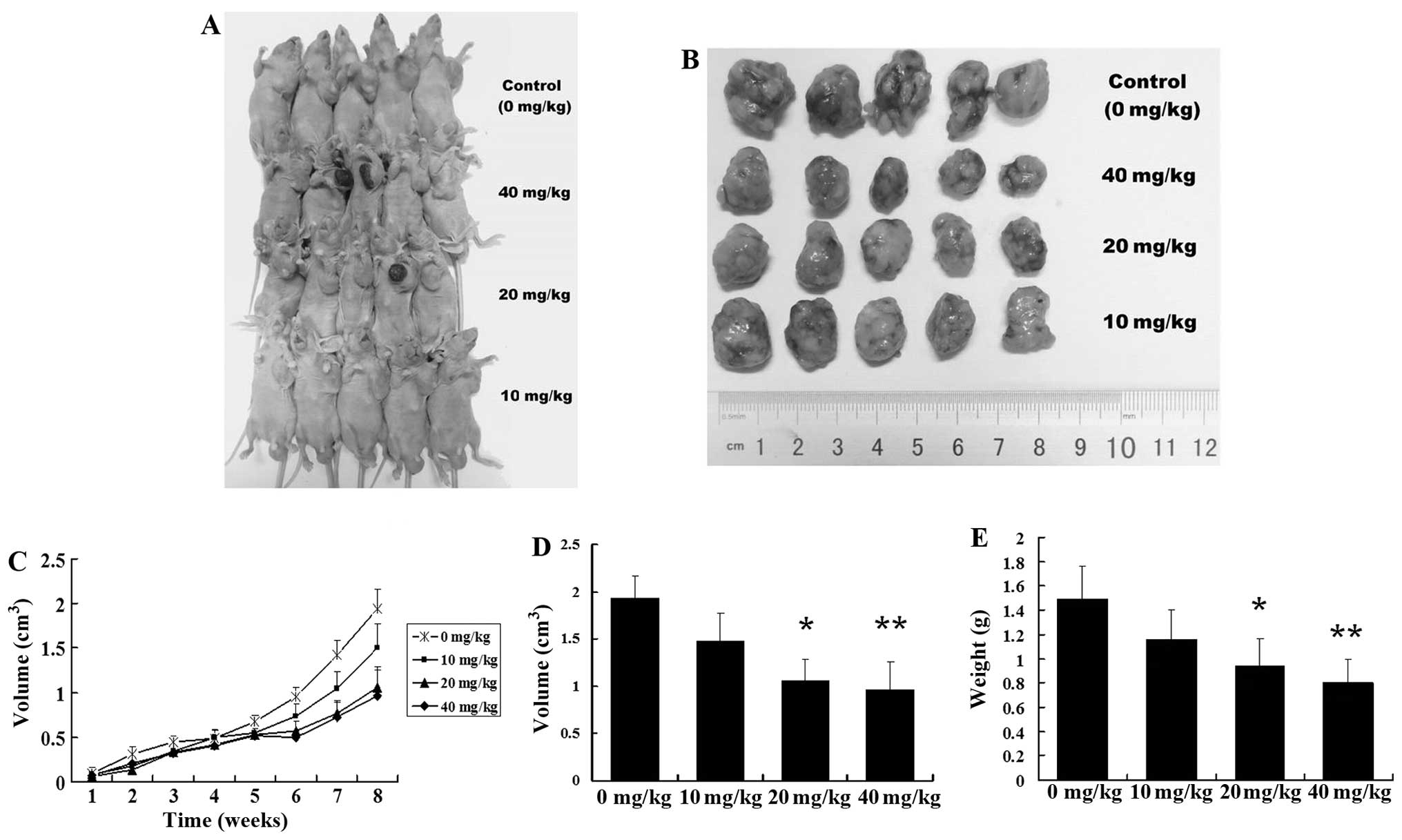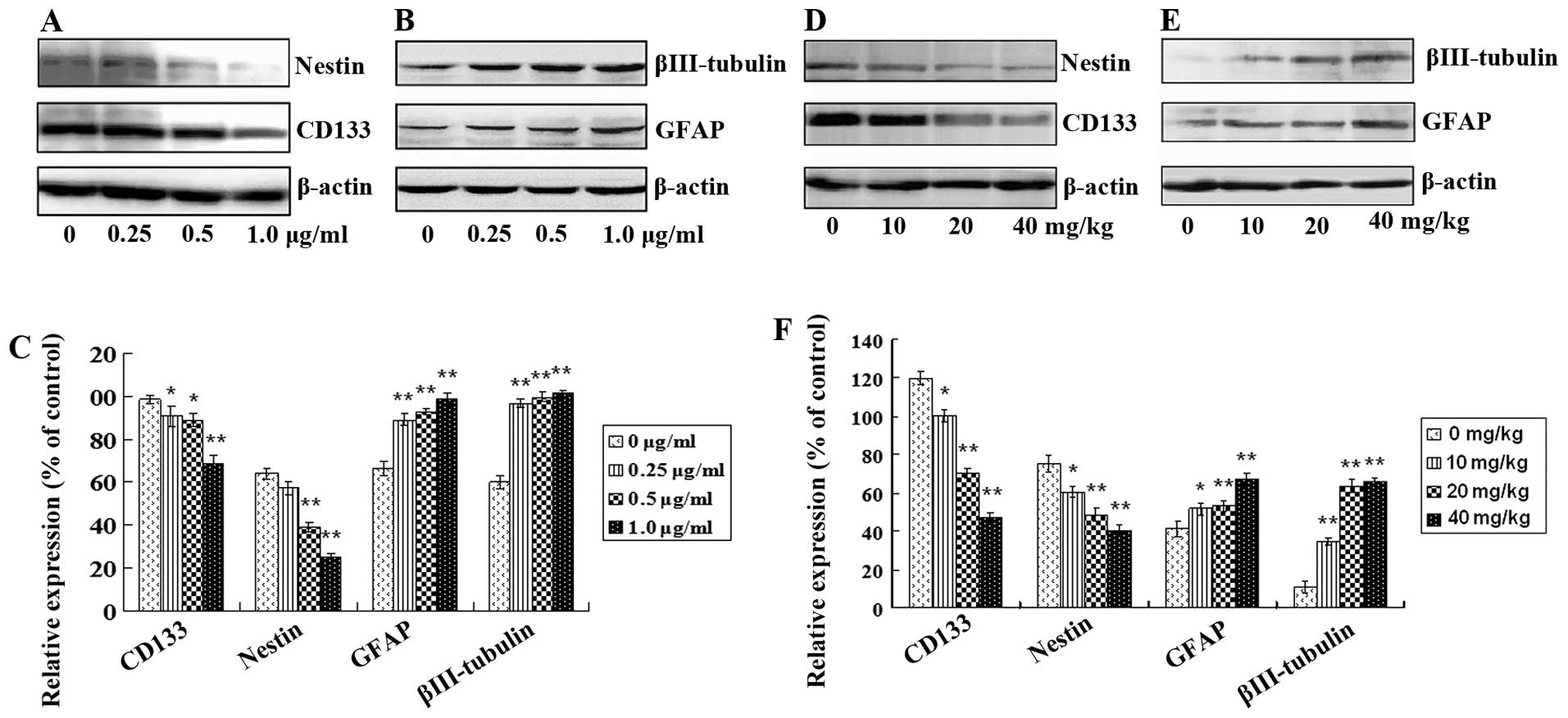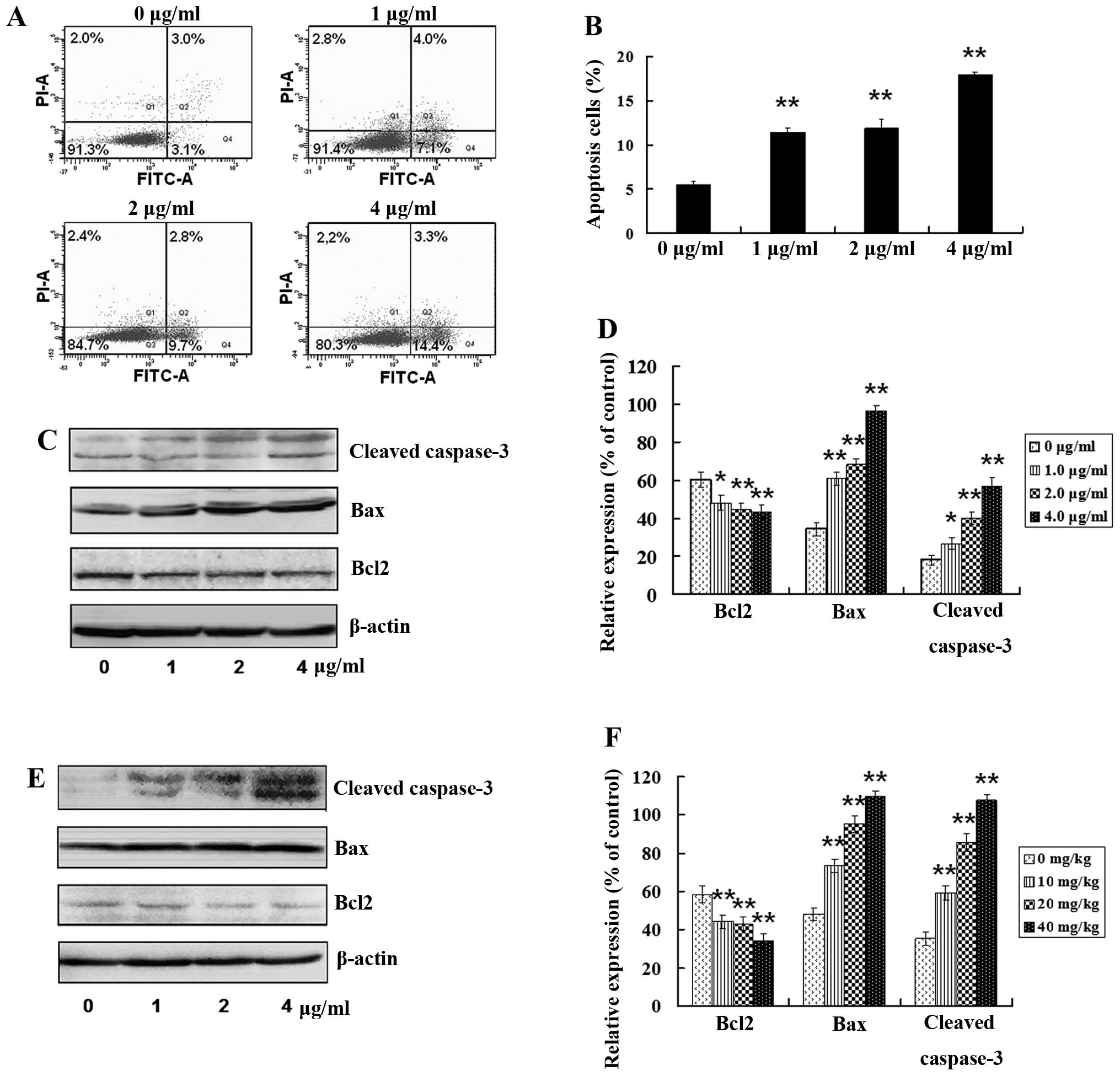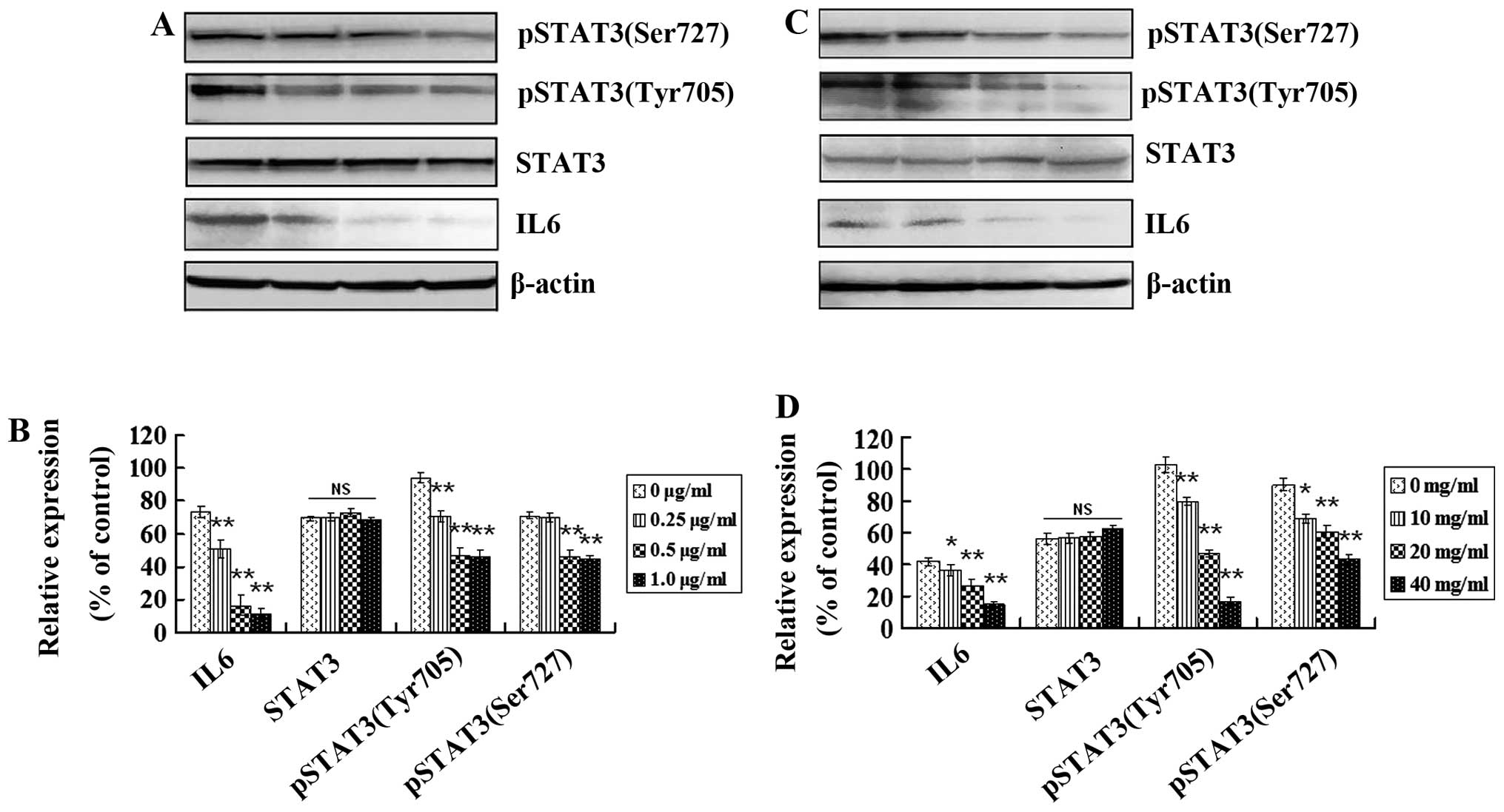Tanshinone IIA inhibits the growth, attenuates the stemness and induces the apoptosis of human glioma stem cells
- Authors:
- Published online on: June 26, 2014 https://doi.org/10.3892/or.2014.3293
- Pages: 1303-1311
Abstract
Introduction
Glioblastoma multiforme (GBM, grade IV astrocytoma) is considered to be the most highly malignant brain tumor (1). GMB is highly aggressive and currently incurable. While many patients with low-grade gliomas survive for many years, the median survival time of GBM patients is only 12 months (2). The poor prognosis is mainly attributed to the highly diffusive growth pattern of GBM cells into surrounding brain tissue, thereby preventing complete surgical removal (3). There has been a negligible decrease in the mortality rate of GBM patients over the past few decades, indicating that GBM is a complex disease and not easy to cure. Therefore, the development of more effective therapies for GBM must cope with recurrence through elimination of residual single cells or microscopic cell clusters.
Cancer stem cells (CSCs) are a subpopulation of tumor cells with the ability to undergo self-renewal and propagate the tumor population (4). Increasing evidence suggests that CSCs also exist in the GBM population and this CSC subpopulation is referred to as glioma stem cells (GSCs) (5–9). GSCs possess the abilities for self-renewal and multiple differentiation, but also have greater tumorigenic potential than matched non-stem tumor cells when xenotransplanted into immunocompromised rats (7). In addition, GSCs are resistant to chemotherapy and radiotherapy (10,11). Conventional cancer treatments often fail to eliminate GSCs completely, leading to tumor repopulation and relapse (12,13). Thus, targeting GSCs is considered a novel therapeutic avenue to more effectively eradicate malignant tumors and reduce the risk of relapse.
Tanshinone IIA is a lipophilic diterpene isolated from Salvia miltiorrhiza (Danshen), a widely used Chinese herbal medicine (14). A number of studies have shown that tanshinone IIA possesses anticancer (15,16), anti-inflammatory (17,18) and anti-oxidative (19) activities in vitro and in vivo through the inhibition of special signaling pathways (20,21), suggesting it may be an effective chemotherapeutic agent for malignant tumor therapy.
Previous studies have shown that CSCs are maintained by inflammatory signaling pathways and the microenvironment (22,23) in which inflammatory cytokine interleukin 6 (IL6) (22) plays an important role. Tanshinone IIA was found to exhibit a potent inhibitory effect on the expression of inflammatory cytokines (21,24). Therefore, the anti-inflammatory activity of tanshinone IIA may be a potential therapeutic strategy for tumor inhibition through the downregulation or attenuation of the expression of inflammatory cytokines.
In the present study, we investigated the effect of serum-free medium (SFM) on GSC formation and examined the effects of tanshinone IIA on human GSCs in vitro and in vivo, and aimed to elucidate the potential molecular mechanisms of its antitumor effect.
Materials and methods
Cell culture and clone formation
Human WJ1 (25) cells were cultured in DMEM/F12 supplemented with 10% FBS (SCM), penicillin (100 U/ml) and streptomycin (100 μg/ml) in a humidified atmosphere of 50 μg/ml CO2 at 37°C until formation of an adherent monolayer of GBM cells. Then cells from the serum-grown cultures were dissociated and cultured with serum-free DMEM/F12 medium supplemented with 20 ng/ml EGF, 20 ng/ml bFGF, and 1X B27 (Invitrogen, Carlsbad, CA, USA), until primary neurosphere formation (26). Neurospheres were photographed using an inverted microscope after neurosphere formation.
RT-PCR
Total RNA was harvested from cells using TRIzol reagent (CWBIO). PCR was performed on cDNA generated by HIFI-MMLV reverse transcriptase (CWBIO) in a total reaction volume of 20 μl according to the manufacturer’s instructions. The sequences of forward and reverse oligonucleotide primers, specific to the chosen candidates and housekeeping genes, were used as follows: CD133 forward, 5′-CGACTGAGACCCAACATC-3′ and reverse, 5′-CCCTTTT GATACCTGCTACGAC-3′; GFAP forward, 5′-CGATCAACT CACCGCCAACA-3′ and reverse, 5′-GTGGCTTCATCTGCT TCCTGTC-3′; GAPDH forward, 5′-ACCACAGTCCATGCCA TCAC-3′ and reverse, 5′-TCCACCACCCTGTTGCTGTA-3′. All data were normalized to GAPDH transcript levels.
Western blotting
Western blotting was performed as previously described (3). Rabbit polyclonal antibodies for human CD133 (1:500 dilution; Signalway Antibody, Preland, TX, USA), nestin, GFAP, βIII-tubulin, IL6, Bax, cleaved caspase-3, Bcl2, signal transducer and activator of transcription 3 (STAT3), phospho-STAT3(tyrosine705) and phospho-STAT3(serine727) (1:500 dilution; Bios Biotechnology, Beijing, China) were used according to the manufacturer’s instructions. Antibody recognition was detected with the peroxidase-conjugated goat anti-rabbit IgG (H+L) secondary antibody (Zhongshan Goldenbridge Biotechnology, Beijing, China) using a 1:3,000 dilution. Antibody-bound proteins were detected by the BeyoECL Plus kit (Beyotime Institute of Biotechnology, Shanghai, China) and western blotting system (Universal Hood II, Bio-Rad, USA), and normalized to β-actin and quantified using the ChemiDoc™ XRS (Bio-Rad).
Tumorigenicity assay
To evaluate the tumorigenicity of the GBMS cells, 1×104, 1×105, 1×106 of GBM cells and 1×102, 1×103, 1×104 of GBMS cells were suspended in 50 μl Matrigel (BD Biosciences) and 50 μl PBS, and then cells were implanted bilaterally into the flank of BALB/c nu/nu mice. Animals were maintained under standard conditions according to the guidelines of the Institutional Animal Care and Use Committee of Sichuan University. Tumor incidence was recorded 3 times weekly after the injection. Mice were maintained on a standard rodent chow and had free access to water. Tumors of the euthanized mice were collected, and their size and weight were measured.
Inhibition of colony formation
Single-cell suspensions of GBMS were seeded in a 96-well plate at a density of 100 cells per well. Cells were treated with tanshinone IIA at concentrations of 0.25, 0.5 and 1.0 μg/ml respectively. Each concentration was repeated in 6 wells. After a 7-day incubation at 37°C in a humidified 5% CO2 atmosphere, the number of neurospheres in each well was quantified under a microscope. Three independent experiments were performed.
MTT assay
The 3-[4,5-dimethylthiazol-2-yl]-2, 5 diphenyltetrazolium bromide (MTT) assay was performed as previously described (27). GBMS, GBM and LO2 (normal control) cells (2×103/well) were seeded in 100 μl of medium/well in 96-well plates. After a 24-h incubation, tanshinone IIA was added at various concentrations (0.125, 0.25, 0.5, 1.0 and 2.0 μg/ml); 5 wells were included for each concentration. The effects of tanshinone IIA on the viability of GBMS, GBM and normal cells was expressed as the % cytoviability, using the following formula: % cytoviability = A490 of the treated cells/A490 of the control cells (without tanshinone IIA) × 100% (28). Three independent experiments were performed.
Annexin V-FITC assay
In order to determine apoptosis in GBMS cells, the Annexin V-FITC apoptosis detection kit (KeyGen Biotech, Nanjing, China) was used according to the manufacturer’s instructions. The extent of apoptosis in the samples was measured by flow cytometry using BD FACSCalibur flow cytometer and CellQuest software. Three independent experiments were performed.
In vivo inhibition assay
The flank xenografts were established by subcutaneous injections of 104 GSCs per flank (5 mice per group). Animals were maintained under standard conditions according to the guidelines of the Institutional Animal Care and Use Committee of Sichuan University. After one week of inoculation, the tumor-bearing mice were randomized into four groups, each having 5 mice. The mice of the three treatment groups were injected with 10, 20 and 40 mg/kg of tanshinone IIA i.p. 3 times a week for 8 weeks, respectively, and the control mice were injected with an equal volume of blank dissolvant. In the experimental process, mice were weighed, and tumor volumes were assessed each week. At the end of the experiment, the mice were sacrificed by carbon dioxide asphyxiation and tumors were harvested, weighed and examined. The tumor inhibitory rate was calculated using the following formula: Tumor inhibitory rate (%) = (mean tumor weight of the control mice − mean tumor weight of the treated mice)/average tumor weight of the control mice × 100%.
Statistical analysis
Results are expressed as means ± standard deviation. To evaluate the significant differences between two groups, the means were compared using the Student’s t-test. Multiple group comparisons were performed using one-way analysis of variance. The level of statistical significance was defined as P<0.05 for all tests. All statistical analyses were performed using SPSS 16.0 (SPSS, Inc., Chicago, IL, USA)
Results
GBMS exhibit characteristics of GSCs in vitro
GBM cells exhibited adherent growth in SCM (Fig. 1A). We switched the GBM cells into culture conditions for GSC proliferation in vitro. Primary neurosphere-like colonies (GBM neurospheres; GBMS) were observed in the SFM after 10–14 days (Fig. 1B). We next digested these neurosphere-like colonies into single-cell suspensions and were seeded at a clonal density in the SFM in a 24-well plate. Subspheres appeared after culturing for 7–10 days. This result indicated that GBMS contained individual stem-like cells with the ability to self-renew and form new spheres.
The level of the CD133 transcript was significantly higher in the GBMS when compared with the GBM cells. In contrast, the GFAP transcript was obviously lower in the spheres than that in the GBM cells (Fig. 2A and B; P<0.05). Western blotting data showed that the protein levels of stemness and differentiation markers of GSCs were in agreement with the immunofluorescence and gene expression (Fig. 2C). These results indicated that the stem-like characteristic of GBMS were enriched when grown in SFM.
GBMS display higher tumorigenicity than GBM cells in vivo
To confirm the different tumor-initiating capabilities between GBMS and GBM cells in vivo, both spheres (1×102, 1×103, 1×104 cells) and adherent monolayer cells (1×104, 1×105, 1×106 cells) were implanted bilaterally into the flank of BALB/c nu/nu mice for analysis of transplanted tumorigenicity. GBMS cells generated tumors when only 1×102 cells were injected into mice. In contrast, at least 1×105 GBM cells were needed to generate tumors, suggesting that GBMS contain more tumor-initiating cells by at least 1,000-fold when compared to this number in the parental cells. A comparative analysis of gross appearance revealed the presence of significant differences regarding the size and mass between the tumors newly generated from the GBM and GBMS cells after implantation for 6 weeks (Fig. 2D–F; P<0.05). This result indicates that the tumorigenicity of GBMS cells was significantly higher than that of the GBM cells.
Tanshinone IIA inhibits GSC (GBMS) proliferation in vitro
To determine whether tanshinone IIA suppresses GSC proliferation, we compared the inhibitory effect of tanshinone IIA on human GSCs, GBM and normal control (LO2) cells and under proper drug concentrations after treatment for 1–5 days, respectively. The inhibition of tanshinone IIA at various concentrations in these cells was determined as the ratio of the number of viable treated cells to the number of viable cells of the untreated controls. Tanshinone IIA exhibited a dose- and time-dependent inhibitory effect on GSCs, GBM and normal cells (Fig. 3A–C). The IC50 value was 2.542±0.34 μg/ml for normal cells, 2.066±0.135 μg/ml for GBM cells and 1.812±0.196 μg/ml for GSCs, respectively, after 72 h of treatment (Fig. 3D; P<0.05). Our results showed that, compared with GBM and normal cells, GSCs were more sensitive to tanshinone IIA in vitro, suggesting that tanshinone IIA possesses stronger inhibitory activity against GSCs.
Tanshinone IIA inhibits neurosphere formation
To test the inhibitory effect of tanshinone IIA on neurosphere formation in GSCs, we incubated single-cell suspensions of GBMS with escalating concentrations of tanshinone IIA and evaluated neurosphere formation on day 7. We found that there was a dose-dependent reduction in neurosphere formation after treatment with tanshinone IIA (Fig. 3E). The mean number of neurospheres in the control were 26.0±4.0 after seeding 100 cells per well, whereas the mean numbers of neurospheres treated with 0.25, 0.5 and 1.0 μg/ml of tanshinone IIA for 48 h were 17.0±1.0 (P<0.05), 12.0±2.0 (P<0.01) and 7.33±1.15 (P<0.01), respectively (Fig. 3F). A significant reduction in the number of neurospheres was observed at concentrations of tanshinone IIA as low as 0.25 μg/ml. Following exposure to tanshinone IIA at a dose of 1.0 μg/ml, neurosphere formation of GSC decreased sharply.
Tanshinone IIA inhibits the growth of GSC-derived tumors
To investigate the inhibitory activity of tanshinone IIA on human GSCs in vivo, human GSC-bearing mice were injected with 10, 20 or 40 mg/kg of tanshinone IIA i.p. 3 times a week for 8 weeks. Tanshinone IIA potently inhibited the growth of GSC-derived xenografts with a reduction in tumor weight and volume (Fig. 4A–C). In contrast, the controls were not significantly inhibited in terms of tumor growth. The mean tumor volume of the control mice was 1.92±0.40 cm3, and those of the mice injected with 10, 20, and 40 mg/kg of tanshinone IIA were 1.34±0.49, 1.02±0.38 (P<0.05) and 0.90±0.36 cm3 (P<0.01), respectively (Fig. 4D). The mean tumor weight of the control mice was 1.49±0.27 g, and those of the mice injected with 10, 20 and 40 mg/kg of tanshinone IIA were 1.16±0.24, 0.94±0.22 (P<0.05) and 0.80±0.20 g (P<0.01), respectively (Fig. 4E). The tumor inhibitory rates were 22.14, 36.91 (P<0.05) and 46.30% (P<0.05), respectively. No evidence of toxicity was identified in the treated animals by comparing the body weight increase, histopathological changes in major organs, and blood biochemistry analysis of both the control and the treated group animals (data not shown).
Tanshinone IIA attenuates GSC stemness and induces GSC apoptosis
After treatment with tanshinone IIA, protein expression levels of GSC markers including CD133 and nestin and differentiation and neural lineage markers including GFAP for astrocytes and βIII-tubulin for neurons in vitro and in vivo were analyzed. CD133 and nestin in GSCs were decreased both in vitro and in vivo in a dose-dependent manner (Fig. 5A and D; Fig. 5C and F; P<0.05). In contrast, the levels of GFAP and βIII-tubulin were increased in a dose-dependent manner (Fig. 5B and E; Fig. 5C and F; P<0.05). Furthermore, tanshinone IIA treatment resulted in th apoptosis of GSCs. As shown in Fig. 6A, the number of apoptotic cells was significantly increased following treatment with tanshinone IIA. Tanshinone IIA exposure resulted in a more than 3-fold increase in Annexin V-positive cells (Fig. 6B), which was highly significant (P<0.01). Moreover, expression levels of apoptosis-related proteins were examined in vitro and in vivo after treatment with tanshinone IIA. Bax and cleaved caspase-3 (apoptotic proteins) were increased and anti-apoptotic protein Bcl-2 was decreased in a dose-dependent manner after treatment with 1.0, 2.0 or 4.0 μg/ml of tanshinone IIA for 24 h in vitro (Fig. 6C and D; P<0.05). Apoptosis-related proteins in tumors from human GSC bearing-mice were examined after treatment with 10, 20 and 40 mg/kg of tanshinone IIA for 8 weeks. Bax and cleaved caspase-3 were increased, and Bcl-2 was decreased in a dose-dependent manner (Fig. 6E and F; P<0.05), which was in consistent with the in vitro results. These results indicate that tanshinone IIA has the potential not only to attenuate GSC stemness, but also to induce GSC apoptosis in vitro and in vivo.
Tanshinone IIA regulates protein expression mediating inflammatory signaling pathways in GSCs
Inflammatory cytokines play important roles in the maintenance and progression of CSCs. To understand the molecular mechanisms underlying the inhibitory effect of tanshinone IIA on GSCs, we examined protein expression profiles mediating inflammatory signaling pathways. Inflammatory cytokine IL6, STAT3 and the active form of STAT3 [(phospho-STAT3(tyrosine705) and phospho-STAT3(serine727)] in GSCs in vitro and in vivo were analyzed using western blotting. Expression levels of IL6, phospho-STAT3(tyrosine705) and phospho-STAT3(serine727) were higher in the GSCs from cells and tumor tissues (Fig. 7A and C, respectively). IL6, phospho-STAT3(tyrosine705) and phospho-STAT3(serine727) were decreased in vitro after treatment with 0.25, 0.5 and 1.0 μg/ml of tanshinone IIA for 48 h and in vivo after treatment with 10, 20 and 40 mg/kg of tanshinone IIA for 8 weeks (Fig. 7B and D; P<0.05). However, no significant expression change in STAT3 was observed after treatment with different concentrations of tanshinone IIA (Fig. 7B and D; P>0.05). These results suggest that IL6 and downstream activated STAT3 play roles in GSC growth, and tanshinone IIA has the potential to block inflammatory signaling pathways in GSCs by downregulating pathway-related protein expression.
Discussion
GBM is an extremely lethal tumor that is highly resistent to therapy, and achieving a cure through surgical intervention is difficult. Previous research has shown that therapeutic resistance of GBM is caused by the selective survival of highly tumorigenic GSCs (9). It is critical for cancer therapy that treatments target and eliminate these resistent population of stem-like cells (29). Therefore, it is necessary to culture and enrich GSCs in GBM cells in order to identify their aggressive mechanisms and then aim to eliminate GSCs in patients.
In the present study, we successfully isolated GBMS from the human GBM cell line WJ1. GBMS exhibited properties of GSCs, including the ability for self-renewal, exhibited pale with toluidine blue, expression of known GSC markers and high tumorigenicity in vivo. These lines of evidence confirmed the isolation of GSCs from WJ1.
A previous study showed that GSCs play core roles in the therapeutic resistance of GBM (9). Thus, targeting malignant GSCs using therapeutic drugs that have the potential to eliminate the most aggressive GSCs but preserve neural cell populations should be the preferred treatment measure in experimental research. Tanshinone IIA has anticancer (30,31) and anti-inflammatory (14,17,18) activities. In the present study, following GSC exposure to tanshinone IIA, the formation of neurospheres was reduced in a dose-dependent manner and the cell viability of GSCs was suppressed in a dose- and time-dependent manner. These results suggest that tanshinone IIA has strong anti-GSC activity. In an in vivo experiment, tanshinone IIA slowed the growth of human brain cancer derived from GSCs, and significantly reduced the weight and volume of tumor masses without any untoward toxicity. These findings demonstrated that using tanshinone IIA has a potential inhibitory effect on GSCs in vitro and in vivo.
Since CSCs play a core role in cancer recurrence, metastasis and high patient mortality, targeting and attenuating CSC stemness, induction of CSC differentiation and apoptosis are promising treatment avenues other than targeting tumor masses in the treatment of a malignant tumors. Friedman et al (32) demonstrated that all-trans retinoic acid (ATRA), a derivative of retinol, causes differentiation of CSCs as well as normal neural progenitor cells by the loss of the stem cell marker nestin. In the present study, expression levels of stemness markers (CD133 and nestin) in GSCs were decreased, and differentiation and neural lineage markers (GFAP and βIII-tubulin) were increased in vitro and in vivo in a dose-dependent manner after treatment with tanshinone IIA. This indicates that the stemness of GSCs was attenuated after treatment with tanshinone IIA. The Annexin V analysis and western blot analysis of apoptotic proteins Bax and cleaved caspase-3 and anti-apoptotic protein Bcl-2 indicated that tanshinone IIA treatment resulted in apoptotic cell death of GSCs. These results suggest that tanshinone IIA has an anti-GSC activity through induction of GSC apoptosis. Taken together, all these data strongly demonstrated that tanshinone IIA has the potential not only to attenuate GSC stemness, but also to induce GSC apoptosis.
It was well recognized that inflammatory cytokines and signaling pathways play pivotal roles in maintaining stem-like properties in human glioma cells (33). Wang et al (34) demonstrated that GSCs preferentially express the IL6 receptors α (IL6Rα) and glycoprotein 130 (gp130), and the targeting of IL6Rα or IL6 ligand expression in GSCs significantly reduces growth and neurosphere formation capacity while increasing apoptosis. Guryanova et al (35) demonstrated that the activation of STAT3 signaling is necessary for maintaining self-renewal and the tumorigenic potential of GSCs. STAT3 is a downstream mediator of pro-survival IL6 signals in GSCs and is constitutively activated in glioma cells. Perturbation of IL6 signaling in GSCs attenuates STAT3 activation, and small molecule inhibitors of STAT3 potently induce GSC apoptosis (34). Thus, it can be seen that the IL6/STAT3 signaling axis plays an important role for GSC maintanence and activity. In the present study, the expression level of IL6 was higher in GSCs and tumor tissue derived from GSC bearing-mice. IL6 levels were downregulated after treatment with tanshinone IIA, indicating that tanshinone IIA has a significant inhibitory effect on IL6 expression in GSCs. The oncogenic potential of STAT3 depends on its phosphorylation on tyrosine705 and serine727 that leads to activation of target gene transcription. Phosphorylated STATs form dimers, translocate to the nucleus using the karyopherin-β nucleocytoplasmic transport system, bind DNA, and activate transcription (36,37). In the present study, activated STAT3 [(STAT3(tyrosine705) and STAT3(serine727)] had high levels in GSCs. Tanshinone IIA not only downregulated the expression levels of IL6 but also decreased activated STAT3 in GSCs in vitro and in vivo in a dose-dependent manner. This result suggests that the IL6/STAT3 signaling axis might mediate the growth and progression of GSCs. Disturbing IL6/STAT3 signaling pathways by tanshinone IIA is closely associated with growth inhibition of GSCs,
Based on the findings in this experimental study, tanshinone IIA inhibits proliferation, attenuates stemness and induces apoptosis in GSCs in vitro and in vivo. Its partial mechanism of activity may be associated with attenuating inflammatory cytokine production and blocking the IL6/STAT3 signaling pathway.
Acknowledgements
This research was supported by the National Natural Science Foundation of China (grant no. 31071197).
References
|
Daumas-Duport C, Scheithauer B, O’Fallon J and Kelly P: Grading of astrocytomas, a simple and reproducible method. Cancer. 62:2152–2165. 1988. View Article : Google Scholar : PubMed/NCBI | |
|
Smith JS and Jenkins RB: Genetic alterations in adult diffuse glioma: occurrence, significance, and prognostic implications. Front Biosci. 5:D213–D231. 2000. View Article : Google Scholar : PubMed/NCBI | |
|
Wang L, Liu Z, Balivada S, Shrestha T, Bossmann S, Pyle M, Pappan L, Shi J and Troyer D: Interleukin-1β and transforming growth factor-β cooperate to induce neurosphere formation and increase tumorigenicity of adherent LN-229 glioma cells. Stem Cell Res Ther. 3:52012. | |
|
Jordan CT: Cancer stem cells: controversial or just misunderstood? Cell Stem Cell. 4:203–205. 2009. View Article : Google Scholar : PubMed/NCBI | |
|
Ignatova TN, Kukekov VG, Laywell ED, Suslov ON, Vrionis FD and Steindler DA: Human cortical glial tumors contain neural stem-like cells expressing astroglial and neuronal markers in vitro. Glia. 39:193–206. 2002. View Article : Google Scholar : PubMed/NCBI | |
|
Singh SK, Hawkins C, Clarke ID, Squire JA, Bayani J, Hide T, Henkelman RM, Cusimano MD and Dirks PB: Identification of human brain tumour initiating cells. Nature. 432:396–401. 2004. View Article : Google Scholar : PubMed/NCBI | |
|
Galli R, Binda E, Orfanelli U, Cipelletti B, Gritti A, De Vitis S, Fiocco R, Foroni C, Dimeco F and Vescovi A: Isolation and characterization of tumorigenic, stem-like neural precursors from human glioblastoma. Cancer Res. 64:7011–7021. 2004. View Article : Google Scholar : PubMed/NCBI | |
|
Bao S, Wu Q, McLendon RE, Hao Y, Shi Q, Hjelmeland AB, Dewhirst MW, Bigner DD and Rich JN: Glioma stem cells promote radioresistance by preferential activation of the DNA damage response. Nature. 444:756–760. 2006. View Article : Google Scholar : PubMed/NCBI | |
|
Bao S, Wu Q, Sathornsumetee S, Hao Y, Li Z, Hjelmeland AB, Shi Q, McLendon RE, Bigner DD and Rich JN: Stem cell-like glioma cells promote tumor angiogenesis through vascular endothelial growth factor. Cancer Res. 66:7843–7848. 2006. View Article : Google Scholar : PubMed/NCBI | |
|
Eramo A, Ricci-Vitiani L, Zeuner A, Pallini R, Lotti F, Sette G, Pilozzi E, Larocca LM, Peschle C and De Maria R: Chemotherapy resistance of glioblastoma stem cells. Cell Death Differ. 13:1238–1241. 2006. View Article : Google Scholar : PubMed/NCBI | |
|
Rich JN: Cancer stem cells in radiation resistance. Cancer Res. 67:8980–8984. 2007. View Article : Google Scholar : PubMed/NCBI | |
|
Liu G, Yuan X, Zeng Z, Tunici P, Ng H, Abdulkadir IR, Lu L, Irvin D, Black KL and Yu JS: Analysis of gene expression and chemoresistance of CD133+ cancer stem cells in glioblastoma. Mol Cancer. 5:672006. View Article : Google Scholar : PubMed/NCBI | |
|
Singh SK, Clarke ID, Hide T and Dirks PB: Cancer stem cells in nervous system tumors. Oncogene. 23:7267–7273. 2004. View Article : Google Scholar : PubMed/NCBI | |
|
Yin X, Yin Y, Cao FL, Chen YF, Peng Y, Hou WG, Sun SK and Luo ZJ: Tanshinone IIA attenuates the inflammatory response and apoptosis after traumatic injury of the spinal cord in adult rats. PLoS One. 7:e383812012. View Article : Google Scholar : PubMed/NCBI | |
|
Dai ZK, Qin JK, Huang JE, Luo Y, Xu Q and Zhao HL: Tanshinone IIA activates calcium-dependent apoptosis signaling pathway in human hepatoma cells. J Nat Med. 66:192–201. 2012. View Article : Google Scholar : PubMed/NCBI | |
|
Chiu TL and Su CC: Tanshinone IIA induces apoptosis in human lung cancer A549 cells through the induction of reactive oxygen species and decreasing the mitochondrial membrane potential. Int J Mol Med. 25:231–236. 2010.PubMed/NCBI | |
|
Ren ZH, Tong YH, Xu W, Ma J and Chen Y: Tanshinone IIA attenuates inflammatory responses of rats with myocardial infarction by reducing MCP-1 expression. Phytomedicine. 17:212–218. 2010. View Article : Google Scholar : PubMed/NCBI | |
|
Fan GW, Gao XM, Wang H, Zhu Y, Zhang J, Hu LM, Su YF, Kang LY and Zhang BL: The anti-inflammatory activities of tanshinone IIA, an active component of TCM, are mediated by estrogen receptor activation and inhibition of iNOS. J Steroid Biochem Mol Biol. 113:275–280. 2009. View Article : Google Scholar : PubMed/NCBI | |
|
Chen W, Tang F, Xie B, Chen S, Huang H and Liu P: Amelioration of atherosclerosis by tanshinone IIA in hyperlipidemic rabbits through attenuation of oxidative stress. Eur J Pharmacol. 674:359–364. 2012. View Article : Google Scholar : PubMed/NCBI | |
|
Wang X, Wei Y, Yuan S, Liu G, Lu Y, Zhang J and Wang W: Potential anticancer activity of tanshinone IIA against human breast cancer. Int J Cancer. 116:799–807. 2005. View Article : Google Scholar : PubMed/NCBI | |
|
Su CC and Lin YH: Tanshinone IIA inhibits human breast cancer cells through increased Bax to Bcl-xL ratios. Int J Mol Med. 22:357–361. 2008.PubMed/NCBI | |
|
Iliopoulos D, Hirsch HA, Wang G and Struhl K: Inducible formation of breast cancer stem cells and their dynamic equilibrium with non-stem cancer cells via IL6 secretion. Proc Natl Acad Sci USA. 108:1397–1402. 2011. View Article : Google Scholar : PubMed/NCBI | |
|
Korkaya H, Liu S and Wicha MS: Regulation of cancer stem cells by cytokine networks: attacking cancer’s inflammatory roots. Clin Cancer Res. 17:6125–6129. 2011.PubMed/NCBI | |
|
Jang SI, Jeong SI, Kim KJ, Kim HJ, Yu HH, Park R, Kim HM and You YO: Tanshinone IIA from Salvia miltiorrhiza inhibits inducible nitric oxide synthase expression and production of TNF-alpha, IL-1beta and IL6 in activated RAW 264.7 cells. Planta Med. 69:1057–1059. 2003.PubMed/NCBI | |
|
Wang J, Wang X, Jiang S, Lin P, Zhang J, Wu Y, Xiong Z, Ren JJ and Yang H: Establishment of a new human glioblastoma multiforme cell line (WJ1) and its partial characterization. Cell Mol Neurobiol. 27:831–843. 2007. View Article : Google Scholar : PubMed/NCBI | |
|
Lee J, Kotliarova S, Kotliarov Y, Li A, Su Q, Donin NM, Pastorino S, Purow BW, Christopher N, Zhang W, Park JK and Fine HA: Tumor stem cells derived from glioblastomas cultured in bFGF and EGF more closely mirror the phenotype and genotype of primary tumors than do serum-cultured cell lines. Cancer Cell. 9:391–403. 2006. View Article : Google Scholar : PubMed/NCBI | |
|
van Meerloo J, Kaspers GJ and Cloos J: Cell sensitivity assays: the MTT assay. Methods Mol Biol. 731:237–245. 2011.PubMed/NCBI | |
|
Kim MJ, Kim YJ, Park HJ, Chung JH, Leem KH and Kim HK: Apoptotic effect of red wine polyphenols on human colon cancer SNU-C4 cells. Food Chem Toxicol. 44:898–902. 2006. View Article : Google Scholar : PubMed/NCBI | |
|
Yuan X, Curtin J, Xiong Y, Liu G, Waschsmann-Hogiu S, Farkas DL, Black KL and Yu JS: Isolation of cancer stem cells from adult glioblastoma multiforme. Oncogene. 23:9392–9400. 2004. View Article : Google Scholar : PubMed/NCBI | |
|
Kapoor S: Tanshinone IIA: a potent, natural anti-carcinogenic agent for the management of systemic malignancies. Chin J Integr Med. 15:1532009. View Article : Google Scholar : PubMed/NCBI | |
|
Ma H, Fan Q, Yu J, Xin J and Zhang C: Novel microemulsion of tanshinone IIA, isolated from Salvia miltiorrhiza Bunge, exerts anticancer activity through inducing apoptosis in hepatoma cells. Am J Chin Med. 41:197–210. 2013.PubMed/NCBI | |
|
Friedman MD, Jeevan DS, Tobias M, Murali R and Jhanwar-Uniyal M: Targeting cancer stem cells in glioblastoma multiforme using mTOR inhibitors and the differentiating agent all-trans retinoic acid. Oncol Rep. 30:1645–1850. 2013.PubMed/NCBI | |
|
Jin X, Kim SH, Jeon HM, Beck S, Sohn YW, Yin J, Kim JK, Lim YC, Lee JH, Kim SH, Kang SH, Pian X, Song MS, Park JB, Chae YS, Chung YG, Lee SH, Choi YJ, Nam DH, Choi YK and Kim H: Interferon regulatory factor 7 regulates glioma stem cells via interleukin-6 and Notch signalling. Brain. 135:1055–1069. 2012. View Article : Google Scholar : PubMed/NCBI | |
|
Wang H, Lathia JD, Wu Q, Wang J, Li Z, Heddleston JM, Eyler CE, Elderbroom J, Gallagher J, Schuschu J, MacSwords J, Cao Y, McLendon RE, Wang XF, Hjelmeland AB and Rich JN: Targeting interleukin 6 signaling suppresses glioma stem cell survival and tumor growth. Stem Cells. 27:2393–2404. 2009. View Article : Google Scholar : PubMed/NCBI | |
|
Guryanova OA, Wu Q, Cheng L, Lathia JD, Huang Z, Yang J, MacSwords J, Eyler CE, McLendon RE, Heddleston JM, Shou W, Hambardzumyan D, Lee J, Hjelmeland AB, Sloan AE, Bredel M, Stark GR, Rich JN and Bao S: Nonreceptor tyrosine kinase BMX maintains self-renewal and tumorigenic potential of glioblastoma stem cells by activating STAT3. Cancer Cell. 19:498–511. 2011. View Article : Google Scholar : PubMed/NCBI | |
|
Bromberg J and Darnell JE Jr: The role of STATs in transcriptional control and their impact on cellular function. Oncogene. 19:2468–2473. 2000. View Article : Google Scholar : PubMed/NCBI | |
|
Schindler C, Levy DE and Decker T: JAK-STAT signaling: from interferons to cytokines. J Biol Chem. 282:20059–20063. 2007. View Article : Google Scholar |




